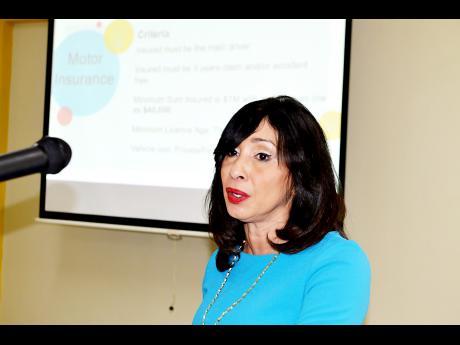Seven smart steps for male road users
With more than 340 persons dying on Jamaica's roads since the start of this year, there is no doubt that the island's roads are very dangerous, but not many Jamaicans are aware of just how dangerous they are for males.
Just over four out of every five persons to die in traffic accidents in Jamaica since the start of this year were males, and Dorothea Ziadie, technical underwriting manager at JN General Insurance Company, has underscored that it gets worse because one almost never hear about the 13,000 persons, mainly men, injured annually in crashes on Jamaican roads.
According to Ziadie, men are both the primary cause of these road risks and the main victims, often in the prime of their lives.
Ziadie is adamant that road users, particularly males, can reduce the dangers to themselves by taking a more proactive approach when behind the wheel.
She has offered seven steps to guide motorists to being safer and healthier road uses.
1. Beware of
crazy drivers
That may include you. Driving defensively is essential as breaking the speed limit is a popular sport, and many will be talking on the phone while driving. It is also not uncommon for drivers to pioneer the creation of second and third lanes of traffic.
A Virginia Tech Transportation Institute's 'Naturalistic Driving Study' found that for every actual crash, drivers usually experience 15 near crashes. Yet many drivers involved in crashes take no evasive measures whatsoever.
2. Be especially wary
of overtakers
One of the basic rules of the Jamaican Road Code is to "drive on the left of the road unless you are about to overtake or turn right". Slow drivers remaining in the overtaking lane can initiate crashes as they trigger unsafe lane changes by faster-moving vehicles. Transportation research in the United States of America suggests that four to 10 per cent of all crashes in that country are caused by unsafe lane changes. Watch out for vehicles in the overtaking lane near you.
3. Spread out
Many cars are too close together in traffic. If you are travelling at 50kmh, you need more than a two-second "space cushion" between your vehicle and the one before you, to keep a reasonable margin of safety. A "space cushion" is the time that it takes for your car to reach the position occupied by the vehicle before you.
For safety, keep one car length between you and the car in front of you for every 10 miles per hour you're are travelling.
4. Stand out
The colour of a car has been found to correlate with accident rates, with the correlation changing based on the light conditions at different times of the day. A Monash University Accident Research Centre study in Australia found that:
n Black and dark-coloured cars have at least a 10 per cent greater likelihood of being involved in a crash;
n White and yellow cars were found to be safest.
Unlike some other research, this study found that silver-coloured cars were more likely to be involved in crashes.
5. Stop it
Your car's stopping distance can save your life, therefore, the condition of your brakes is a major safety issue. Any grinding or unusual sound from the brakes, or if it takes you longer than usual to stop, then your brakes need to be checked. Naturally, you need to have your mechanic do an assessment if your brake warning light comes on while you are driving or if you notice that brake fluid is leaking.
6. Bone up on the road code
You may have been driving for a few years now and forgotten that it was the key road-safety document you needed to pass your driving test. Going through it again will reward you with information you may have forgotten. Remember: "Never use the hard or soft shoulder of the road to overtake." And some people don't seem to know that "at a traffic light-controlled junction, proceed only on the green light as the amber (yellow) light warns drivers approaching a junction to stop".
7. Cool it
One last road risk you may not have heard about, is that: Sitting in a hot car seat can raise the temperature of men's testes to levels that can impair sperm production. According to a study led by Andreas Jung of the University of Giessen in Germany, heated seat or not, just taking a break after driving for two hours improves your concentration and your fertility.
Ziadie concluded that "along with the risks to your safety and health, your financial risks can be mitigated by seeking insurance that offers you good value. Look for the best coverage you can find for the premiums you pay."


